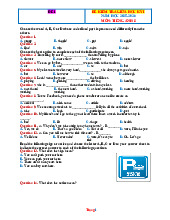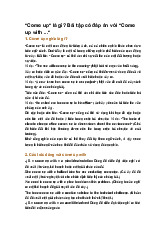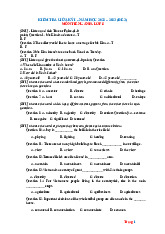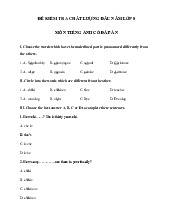











Preview text:
UBND HUYỆN YÊN LẠC
ĐỀ THI GIAO LƯU HSG LỚP 8 CẤP HUYỆN
PHÒNG GIÁO DỤC VÀ ĐÀO TẠO NĂM HỌC 2016 -2017 MÔN: TIẾNG ANH
ĐỀ THI CHÍNH THỨC
( Thời gian làm bài 120 phút, không kể thời gian giao đề)
(Đề thi gồm có 06 trang – Thí sinh làm bài ra tờ giấy thi) PART A: LISTENING.
I. You will hear a telephone conversation between a passenger and an officer at the London Heathrow airport.
Listen to the conversation TWICE and complete the booking form below.
Write ONE WORD OR A NUMBER for each answer.
AIRPORT SHUTTLE BOOKING FORM To: Milton Date: (1) ..................... No. of passengers: One Bus time:
(2) .....................p.m Type of ticket: (3) ..................... Name: Jane Thomson Flight No: AC936 From: London Heathrow Address in Milton:
Vacation Motel, 24, (4) ..................... Street Fare: $ 35 Credit Card No:
(Visa) (5) .....................
II. You will hear people talking about different situations. For each question, choose the best
answer A, B or C.
1. What does the woman say about learning Chinese?
A. It's more difficult to speak than write.
B. She finds the pronunciation easy to learn.
C. The grammar is not so difficult.
2. What does the woman say about her current job?
A. She is able to focus on her work.
B. She finds her colleagues very chatty. Trang 1
C. She likes the atmosphere in the office.
3. What does the man say about travelling alone?
A. There is always someone to talk to.
B. It can be a problem if you are ill.
C. Decisions are easier to make.
4. What does the man plan to do after his voluntary work?
A. Find a job in a zoo.
B. Do a journalism course. C. Work in Borneo. 5. Why is the woman calling?
A. To explain changes in arrangements.
B. Because she's run out of money.
C. To avoid being late for an interview. PART B: PHONETICS.
I. Choose the word whose underlined part is pronounced differently from that of the others 1. A. surprise B. promise C. devise D. realise 2. A. health B. heal C. stealth D. dealt 3. A. hopeful B. postal C. local D. opposite 4. A. cherish B. chorus C. chaos D. scholar 5. A. southern B. account C. south D. amount
II. Find the word with the stress pattern different from that of the other three words in each question. 6. A. industry B. poisonous C. atmosphere D. awareness 7. A. generous B. extensive C. accomplish D. eternal 8. A. medicine B. decide C. distance D. patient 9. A arrangement B. relationship C. scientist D. improve 10. A. discount B. compile C. locator D. website
PART C: VOCABULARY AND GRAMMAR
I. Choose the right word or phrase to complete the sentences.
1. What Marilyn did at the party was certainly ______ bad taste. A. of B. about C. in D. Under Trang 2
2. Your room is messy. Please ______ as much junk as possible and clean it up. A. get rid of
B. make clean of C. drop a line D. stop over
3. Sorry, but that book is ______ . We’ll get some copies from the publisher next Monday. A. out of print B. out of order C. off shelf D. out of stock
4. We ______ gas, so we have to wait until a car passes by. A. gave out on B. ran out of
C. walked out on D. disposed of
5. Politicians should never lose ______ of the needs of the people they represent. A. view B. sight C. regard D. prospect
6. The move to a different environment had brought about a significant _ in Mary’s state of mind. A. impact B. effect C. influence D. chance
7. She ______ regretted having been so unkind. A. bitterly B. severely C. fully D. awfully
8. The color of the handle does not ______ so long as it is the right size. A. worry B. affect C. matter D. concern
9. In some countries environmental organizations have been ______ to inform people and gain their support. A. put up B. made up C. carried out D. set up
10. This clock ______ on two small batteries. A. goes B. works C. runs D. moves.
11. ______ Jenny, everyone admires him for fine sense of humor. A. Except for B. Apart C. Except D. Unless
12. After police found drugs there, the disco was ______ A. closed down B. banned C. ignored D. abolished
13. The injured man was taken to hospital and ______ for international injures. A. cured B. healed C. operated D. treated.
14. According to the __ of the contract, tenants must give six months notice if they intend to leave. A. laws B. rules C. terms D. details
15. Picasso was a ______ cubist painter. A. artistic B. celebrated C. colorful D. knowledgeable. Trang 3
II. There are 8 mistakes in the following passage. Find and correct them.
PREPARING A DINNER PARTY
Giving a dinner party is a wonderful way of entertain people. You can also make new friends and
give other the chance to get to know each other better.
It needs plan, though. First, make a guest list, with different kinds of people and a mixture of
women and men. Don’t invite couples because of they aren’t so much fun.
When you know that can come, find out what they like to eat and drink. Note down any who are
vegetarians, or who can’t eat or drink certain things for religious reasons.
Then plan their menu. Included a first course, a choice of main courses and a dessert, plus lots of people’s favorite drinks.
The next thing to do is the shopping. Make sure you buy more than enough of everything, but
that someone can help you carry it!
On the day, start cooking early. Give people appetizers like Greek mezze or Spanish tapas, such
they don’t get hungry if they have to wait. Serve the delicious meal, sit down with your guests
and have a good time – you’ve earned them!
III. Complete the following sentences by giving the correct form of the words in the blanks.
1. How are you getting on with your (CORRESPOND) ______ course in Russia?
2. What time do you (USE) ______ start work?
3. There was ice on the pavement, which made it very difficult to walk as it was so (SLIP) ______.
4. I could never be a teacher. I am far too (PATIENT) ______.
5. I don’t know what the matter with Tommy is lately. His (BEHAVE) ______ seem to be getting worse and worse.
6. It is becoming (INCREASE) ______ difficult to find a job nowadays.
7. Why money can’t exactly buy you (HAPPY) ____at least it helps you suffer in comfort. PART D: READING
I. Choose the best answer from A, B, C or D to fill in the gaps in the following passage.
MUSIC - A UNIVERSAL LANGUAGE
Music is universal - it is produced by all cultures. Some scientists believe that music
came before speech and (1) ______ as a development of mating calls. In fact, there i s one
theory that the (2) ______ languages were chanted or sung, rather than spoken. Indeed, in some
cultures, music is a form of (3) ______ history. The Aboriginal Australians, for example, use
music as a means to (4) ______ on stories of the land and spirits to the next generation. Trang 4
New evidence suggests that music does not just (5) ______ the feel - good factor but it is
also good for the brain. A study of intellectually (6) ______ children showed that they could
recall more information after it was given to them in a song than after it was read to them as a story.
Researchers also report that people (7) ______ better on a standard intelligence test
after listening to Mozart. The so-called “Mozart effect” has also been (8) ______ by
findings that rats brought up on Mozart run faster through a complex network of paths
or passages, (9) ______ as a maze. Overall, it seems that in most instances people who
suffer from any form of mental (10) ______ benefit from listening to music. 1. A. was B. swelled C. arose D. reacted 2. A. earliest B. newest C. easiest D. simplest 3. A. enjoying B. making C. recording D. stating 4. A. move B. pass C. hand D. happen 5. A. convince B. satisfy C. please D. prefer 6. A. disabled B. inactive C. incapable D. disordered 7. A. examine B. prepare C. achieve D. score 8. A. supported B. given C. marked D. remembered 9. A. called B. heard C. regarded D. known 10. A. badness B. hurt C. illness D. pain
II. Read the following passage and choose the correct answer by circling the corresponding letter A, B, C or D.
In Death Valley, California, one of the hottest, most arid places in North America, there is
much salt, and salt can damage rocks impressively. Inhabitants of areas elsewhere, where streets
and highways are salted to control ice, are familiar with the resulting rust and deterioration on
cars. That attests to the chemically corrosive nature of salt, but it is not the way salt destroys
rocks. Salt breaks rocks apart principally by a process called crystal prying and wedging. This
happens not by soaking the rocks in salt water, but by moistening their bottoms with salt water.
Such conditions exist in many areas along the eastern edge of central Death Valley. There, salty
water rises from the groundwater table by capillary action through tiny spaces in sediment until
it reaches the surface.
Most stones have capillary passages that suck salt water from the wet ground. Death Valley
provides an ultra-dry atmosphere and high daily temperatures, which promote evaporation and
the formation of salt crystals along the cracks or other openings within stones. These crystals
grow as long as salt water is available. Like tree roots breaking up a sidewalk, the growing
crystals exert pressure on the rock and eventually pry the rock apart along planes of weakness,
such as banding in metamorphic rocks, bedding in sedimentary rocks, or preexisting or incipient
fractions, and along boundaries between individual mineral crystals or grains. Besides crystal
growth, the expansion of halite crystals (the same as everyday table salt) by heating and of
sulfates and similar salts by hydration can contribute additional stresses. A rock durable enough Trang 5
to have withstood natural conditions for a very long time in other areas could probably be
shattered into small pieces by salt weathering within a few generations.
The dominant salt in Death Valley is halite, or sodium chloride, but other salts, mostly
carbonates and sulfates, also cause prying and wedging, as does ordinary ice. Weathering by a
variety of salts, though often subtle, is a worldwide phenomenon. Not restricted to arid regions,
intense salt weathering occurs mostly in salt-rich places like the seashore, near the large saline
lakes in the Dry Valleys of Antarctica, and in desert sections of Australia, New Zealand, and central Asia.
1. What is the passage mainly about?
A. The destructive effects of salt on rocks.
B. The impressive salt rocks in Death Valley.
C. The amount of salt produced in Death Valley.
D. The damaging effects of salt on roads and highways.
2. The word "it" in bold refers to _______. A. salty water B. groundwater table C. capillary action D. sediment
3. In paragraph 2, why does the author compare tree roots with growing salt crystals?
A. They both force hard surfaces to crack.
B. They both grow as long as water is available.
C. They both react quickly to a rise in temperature.
D. They both cause salty water to rise from the groundwater table.
4. The word "durable" in bold is closest in meaning to_________. A. large B. strong C. flexible D. pressured
5. The word "shattered" in bold is closest in meaning to_________. A. arranged B. dissolved C. broken apart D. gathered together
6. The word "dominant" in bold is closest in meaning to__________. A. most recent B. most common C. least available D. least damaging
7. According to the passage, which of the following is true about the effects of salts on rocks?
A. Only two types of salts cause prying and wedging.
B. Salts usually cause damage only in combination with ice.
C. A variety of salts in all kinds of environments can cause weathering.
D. Salt damage at the seashore is more severe than salt damage in Death Valley. Trang 6
8. Which of the following can be inferred from the passage about rocks that are found in areas where ice is common?
A. They are protected from weathering.
B. They do not allow capillary action of water.
C. They show similar kinds of damage as rocks in Death Valley.
D. They contain more carbonates than sulfates.
III. Read the following passage and choose the most suitable heading from the list A-I
for each part (1-7) of the passage. There is one extra heading which you do not need to use.
One example has been done for you.
A. Indoor climbing is preferred B. Early imperfections
C. Putting up with nature D. Useful attachments E. Something in common
F. The demand for indoor practice
G. The inventor of the wall
H. A lighter construction method
I. Watching the expert Trang 7 GOING UP THE WALL 0 I
The crowd holds its breath. High above them on the climbing wall, hanging upside down by the
tips of two fingers, is the French climber Francois Lombard. He is competing in the World Cup
Climbing Championships at Birmingham’s National Indoor Arena. 1
The National Indoor Arena is more famous for staging the TV show Gladiators, but the
television programme and the World Cup Climbing Championships share at least one feature -
The Wall. And the fact that either event is possible is the result of a new and rapidly developing technology. 2
Until the mid- 1960s, climbers practiced their skills on cliffs in areas where there was a plentiful
supply of good climbing angles. During the winter they would either tolerate the cold weather,
go walking instead or climb on snow and ice in Scotland. 3
However, as the sport developed it was increasingly important for top climbers to keep fit. With
the cliffs unusable for much of the year, they used brick-edges or stone buildings to ‘work out’
on. This allowed them to keep their fingers strong and beat off the boredom of not being able to
climb. It wasn’t long before many sports centre started building walls specifically for the task,
using bricks with special edges to cling on to. 4
Many of these early walls followed the example set by Don Robison, a teacher of physical
education who, during the mid- 1960s, constructed a climbing wall in corridor of his department
at Leeds University. Robison developed the idea of setting natural rock in a block of concrete,
which could then be included in a wall. 5
Scores of climbing walls of this kind were built in sports halls up and down the country
throughout the 1970s but they had obvious design problems. Walls could only be built in a
vertical plane, whereas cliffs outside have features like overhangs and angled slabs of rock.
There was the added drawback that once the walls were up they couldn’t be altered and climbers
would eventually tire of their repetitive nature, despite thinking of every combination of holds possible. 6
In 1985, a Frenchman, Francois Savigny, developed a material which he moulded into shapes
like those that climbers would find on the cliffs. These could be fixed onto any existing wall and
then taken off when climbers got bored with a particular combination. 7
French manufactures also began to experiment with panels on steel framework. Concrete had
proved too heavy to create overhanging walls without major building work, but steel frames
could be erected anywhere as free - standing structures. A system of interchangeable fixtures
gave climbers an endless supply of new holds. PART E: WRITING Trang 8
I. Rewrite each of the following sentences in such a way that it has a similar meaning to the
original one. You must not change the word given.
1. There is no point in waiting any longer. He’s not going to come. (WORTH)
→ It ___________________________________________________________.
2. They said he wasn’t tall enough to play basketball in the national team. (TOO)
→ According ____________________________________________________.
3. The number of students applying for our scholarship has increased dramatically. (INCREASE)
→ There has ____________________________________________________.
4. “You broke my bicycle, Minh!” said Hoa. (ACCUSED)
→ Hoa _______________________________________________________.
5. He was so angry that he was lost for words. (ANGER)
→ Such was ____________________________________________________.
II. Write a paragraph within 150 words on the following topic.
“Social network sites like Facebook are not good for teenagers, especially students at lower
secondary schools.”
Do you agree or disagree with the following statements?
Use specific reasons and details to support your answer
---------------The and---------------
( Cán bộ coi thi không giải thích gì thêm)
Họ và tên thí sinh:................................................................... Số báo danh:.................. HƯỚNG DẪN CHẤM
PART A: LISTENING (10 points – 1p/ item) I. 1. 17th October 2. 12.30 3. Single/ one-way 4. Kitchener 5. 3303 8450 2045 6837 II. Trang 9 1. C 2. A 3. C 4. A 5. A
PART B: PHONETICS (10pt – 1p/ item) I. 1. B 2. B 3. D 4. A 5. A II. 6. D 7. A 8. B 9. C 10. B
PART C: VOCABULARY & GRAMMAR (30 points)
I. (15 points -1p/ item) 1. C 2. A 3. D 4. B 5. B 6. D 7. D 8. C 9. D 10. C 11. A 12. A 13. D 14. C 15. B
II. (8 points – 1p/ item) Mistake Correction Mistake Correction 1 other others 5 Included Include 2 plan planning 6 but and 3 because of because 7 such so 4 that who 8 them it
III. (7points – 1p/ item) 1. correspondence 5. behavior 2. usually 6. increasingly 3. slippery 7. happiness 4. impatient
PART D: READING (25 points) Trang 10
I. (10 points – 1p/ item) 1. C 2. A 3. C 4. B 5. B 6. A 7. D 8. A 9. D 10. C
II. (8 points – 1p/ item) 1. A 2. A 3. A 4. B 5. C 6. B 7. C 8. C
III. (7points – 2p/ item) 1. B 2. G 3. C 4. F 5. A 6. C 7. H
PART E: WRITING (25 points)
I. 5 points – 1p/ item
1. It is not worth waiting any longer. He’s not going to come.
2. According to them, he was too short to play basketball in the national team.
3. There has been a dramatic increase in the number of students applying for our scholarship.
4. Hoa accused Minh of breaking her bicycle/ Hoa accused Minh of having broken her bicycle
5. Such was his anger that he was lost for words.
II. 20 points Correct form
of - Contents: a provision of all main reasons and appropriate supporting paragraph writing
ideas and relevant examples (10pts) (20 points)
- Language: a variety of vocabulary and appropriate structures (5pts)
- Presentation: coherence, cohesion, and appropriate style (5pts) Incorrect form
of - Contents: a provision of all main reasons and appropriate supporting paragraph writing
ideas and relevant examples (8pts) (15points)
- Language: a variety of vocabulary and appropriate structures (4pts)
- Presentation: coherence, cohesion, and appropriate style (3p) * Total: 100 points. Trang 11 Trang 12




